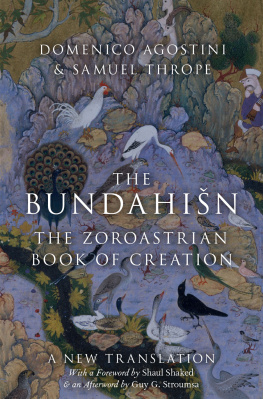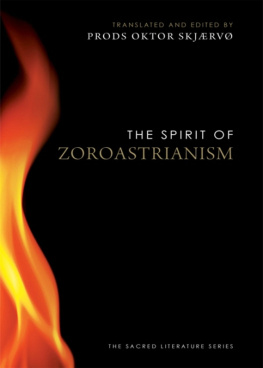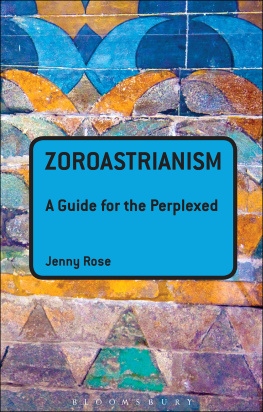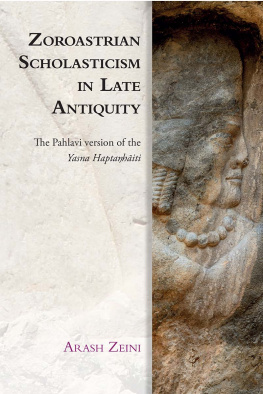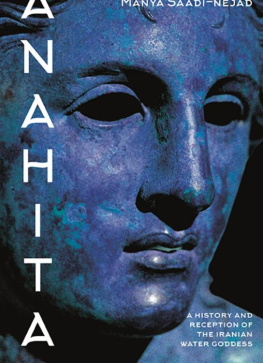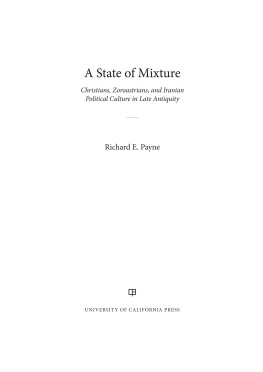The Bundahin


Oxford University Press is a department of the University of Oxford. It furthers the Universitys objective of excellence in research, scholarship, and education by publishing worldwide. Oxford is a registered trade mark of Oxford University Press in the UK and certain other countries.
Published in the United States of America by Oxford University Press
198 Madison Avenue, New York, NY 10016, United States of America.
Oxford University Press 2020
All rights reserved. No part of this publication may be reproduced, stored in a retrieval system, or transmitted, in any form or by any means, without the prior permission in writing of Oxford University Press, or as expressly permitted by law, by license, or under terms agreed with the appropriate reproduction rights organization. Inquiries concerning reproduction outside the scope of the above should be sent to the Rights Department, Oxford University Press, at the address above.
You must not circulate this work in any other form and you must impose this same condition on any acquirer.
Library of Congress Cataloging-in-Publication Data
Names: Agostini, Domenico, translator. | Thrope, Samuel, 1980 translator.
Title: The bundahin : The Zoroastrian Book of Creation /
Domenico Agostini and Samuel Thrope ;
with a Foreword by Shaul Shaked and an Afterword by Guy G. Stroumsa.
Other titles: Bundahishn. English.
Description: New York : Oxford University Press, 2020. |
Includes bibliographical references and index.
Identifiers: LCCN 2019040657 (print) | LCCN 2019040658 (ebook) |
ISBN 9780190879044 (hardback) | ISBN 9780190879068 (epub) |
ISBN 9780190879051 (updf) | ISBN 9780190879075 (online)
Subjects: LCSH: Pahlavi languageTextsTranslations into English. |
Bndahishn. | ZoroastrianismEarly works to 1800.
Classification: LCC PK6197 .B813 2020 (print) | LCC PK6197 (ebook) |
DDC 891/.53dc23
LC record available at https://lccn.loc.gov/2019040657
LC ebook record available at https://lccn.loc.gov/2019040658
In memory of Saul Friedman and Gherardo Gnoli
Contents
Shaul Shaked
Guy G. Stroumsa
is like the ch-sound in church
(Greek gamma) is the sound of the Spanish g between vowels, as in haga
(schwa) is like the e in fed
(agma) is like the ng-sound in sing
and are like the sh-sound in short
(Greek theta) is like the th-sound in think
x is like the ch-sound in loch
is the voiced sound of English measure
Shaul Shaked
Undertaking a translation of the Bundahin, one of the essential books of Zoroastrianism, requires some courage. Several renowned scholars have worked on this text over the past century and have not managed to bring their work to fruition. It seems almost a miracle that the present translation is now completed. Access to the Bundahin in contemporary English translation based on the latest scholarly literature will certainly benefit those who are interested in the Zoroastrian religion, one of the oldest and still living religions in the world, and perhaps to its contacts with other religions.
This treatise got its written shape more than a millennium ago, perhaps after a period of oral transmission. It presents the Zoroastrian view of the world, beginning with an outline of its history, from creation to its transformation into the new world of eschatology. The world of the mixture, the actual universe in which we live, receives a detailed description, including an enumeration of minerals, vegetation, the animal kingdom, the types of human beings, and much more. It opens up for us in a compact scope the complex and intricate reflection of a religion that has its roots in the Indo-European tradition. Understanding and translating it is far from a simple matter, for it uses a language and script that are not always easy to interpret due to an adaptation of a variety of Aramaic scripts for rendering the Middle Persian language.
An earlier phase of Zoroastrian literature has partly survived. We still have access to portions of the ancient canon of scriptures, the Avesta, which has a long history of oral transmission. The Zoroastrian religion and its scripture suffered also from a tumultuous political history that ended with the Islamic conquest of Iran. How far back was the emergence of the sacred scripture, which was composed in more than one variety of Old Iranian, is not entirely clear. Most scholars nowadays would place the earliest parts of the Avesta more than three thousand years ago.
The Bundahin was created in the second major phase of Zoroastrian religious literature, where it occupies a very prominent position. It presents a mature and sophisticated formulation of the original tradition. Zoroastrianism, like other great religious traditions, went through phases of change and adaptation. It is not always easy to follow in detail the transformations that this tradition underwent because so much of its early existence has been lost in the rise and fall of dynasties and the loss of literary and material artifacts. While preserving and promoting several key themes that are part of the ancient scriptures, the Bundahins version of the Zoroastrian religion reflects to some extent the intellectual currents prevalent at the time of its composition in the ninth century ce. This includes some elements of Greek thinking and science as well as ideas that became popular in the Islamic period. It deals with the structure of the material world and provides an understanding of how and why the creation of this world was necessary, indeed almost inevitable. Knowledge of the material world is as much a fundamental part of the faith as an understanding of the divine world and of the world to come, the eschatological world.
There is a marked element of dualism in all phases of Zoroastrianism. Dualism is naturally the central theme in the Bundahins treatment of the myth of creation. Two types of dualism are clearly present in this account. One is ethical: it distinguishes between good and evil entities. The other is ontological, referring to the distinction between that which is visible and tangiblewe may call it material (gtg in Middle Persian)and that which is invisible and intangible, or spiritual (mng in the language of the Zoroastrian texts). In contrast to the more familiar types of dualism in Judaism, Christianity, Islam, and the Gnostic schools, these two types of dualism operate in Zoroastrianism independently of each other. In other words, the invisible (or spiritual) form of existence is not necessarily good, and the material world is not necessarily evil. Good and evil entities can each be spiritual or material.
Contrary to what we may expect, it is good, and not evil, that is more closely associated with material existence. While both good and evil have a spiritual form of existence, they do not function in the same manner in the material world. The visible world is exclusively a creation of Ohrmazd, while the evil entity, Ahriman, has no real share in the material mode of existence. He is nothing but a destructive spirit; his activity is aimed at creating havoc and bringing about destruction.
The Hellenistic world exercised a strong influence on the formation of late Judaism and on the religions that emerged from it, in particular Christianity and Islam. The association of evil with the material world is derived from the trends of thought that were developed in the schools of Neoplatonism and Gnosticism. Zoroastrianism, in contrast, rejected the claim that the Evil Spirit is a product of the material world. He is regarded in Zoroastrianism as a spirit who invaded the material world in order to destroy it. It may be noted that the sect of the Dead Sea Scrolls is the only form of ancient Judaism that is close in structure to this Iranian point of view.

